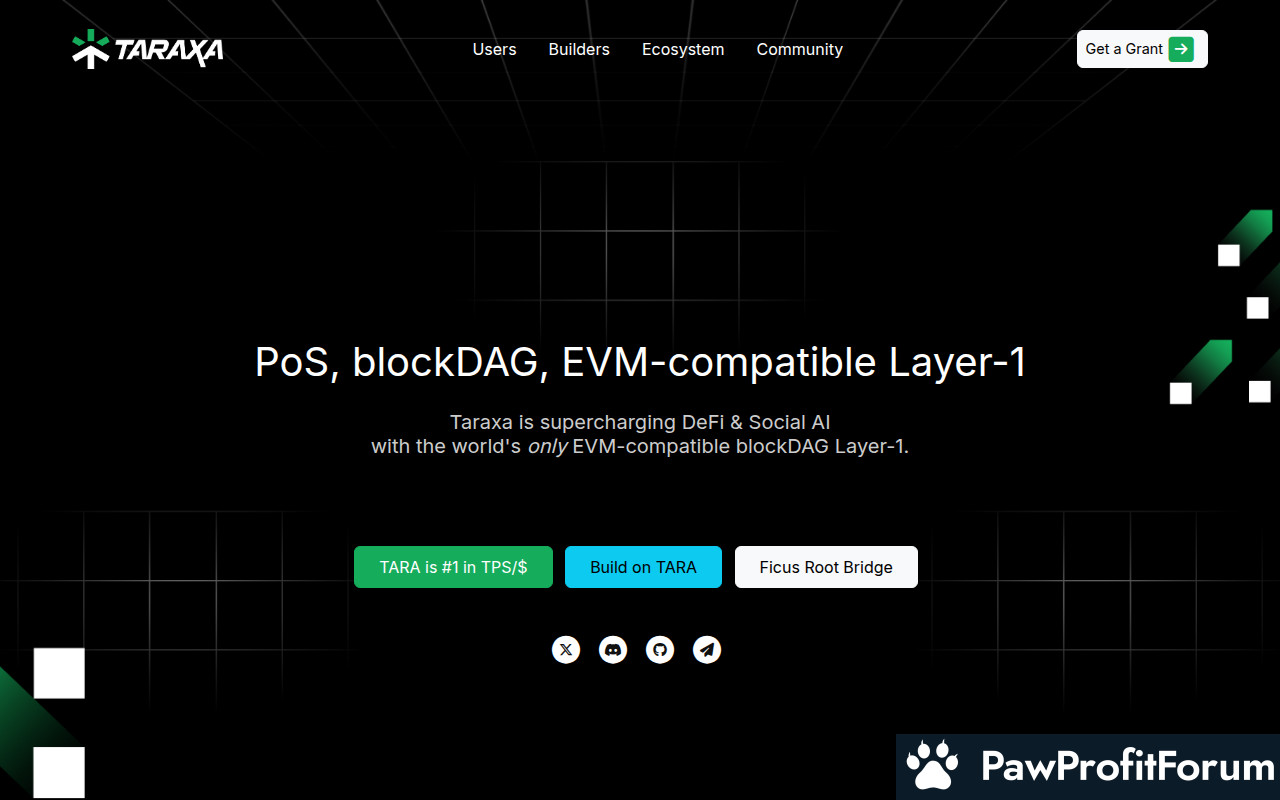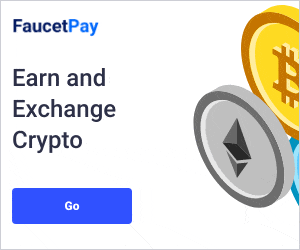Taraxa is an EVM-compatible smart contract platform based on t-Graph consensus utilizing blockDAG, enabling web3 to solve real-world problems.
At the core of Taraxa's technology is its EVM-compatible smart contract platform, which leverages the t-Graph consensus mechanism and blockDAG architecture. This combination ensures high throughput and low latency, making it suitable for a wide range of decentralized applications. The t-Graph consensus is particularly notable for its ability to handle complex transaction workflows efficiently.
The native token, TARA, plays a crucial role within the Taraxa ecosystem. It is used for various purposes, including voting on governance proposals, paying gas fees for transactions, and staking to secure the network. This multi-faceted utility ensures that TARA is integral to the platform's operations and governance.
Taraxa's innovative approach to blockchain technology extends to its real-world applications. By enabling web3 solutions to address practical problems, Taraxa bridges the gap between decentralized technology and everyday business needs. This focus on real-world utility sets it apart from many other blockchain projects, highlighting its potential to drive meaningful change in how informal data is managed and utilized.
The t-Graph consensus mechanism is a pivotal component of Taraxa's technology. Unlike conventional blockchain consensus algorithms, t-Graph consensus enhances the security and speed of the network by organizing transactions in a graph structure rather than a linear chain. This structure significantly reduces the time required to confirm transactions and increases the overall throughput of the network. By utilizing blockDAG, Taraxa ensures that multiple blocks can be processed simultaneously, further boosting its capacity to handle a large volume of transactions.
Security is a paramount concern for any blockchain, and Taraxa addresses this through its robust consensus mechanism. The t-Graph consensus is designed to be resistant to common attacks, such as double-spending and Sybil attacks. By requiring multiple confirmations and leveraging the interconnected nature of the blockDAG, Taraxa makes it exceedingly difficult for malicious actors to alter transaction history or disrupt the network. This ensures that the integrity and trustworthiness of the blockchain are maintained.
In addition to its innovative consensus mechanism, Taraxa is also EVM-compatible, meaning it can run Ethereum-based smart contracts. This compatibility allows developers to easily port their existing decentralized applications (dApps) to the Taraxa platform, fostering a seamless integration with the broader blockchain ecosystem. This feature enhances the versatility and utility of Taraxa, making it an attractive option for developers looking to leverage its high throughput and security features.
Transparency is another key aspect of Taraxa's technology. The platform is designed to provide clear and verifiable records of transactions, which is crucial for applications that require a high degree of trust and accountability. By ensuring that all transactions are transparent and easily auditable, Taraxa supports use cases in various industries, including supply chain management, finance, and governance.
Moreover, Taraxa's focus on scalability and compatibility extends to its ability to interoperate with other blockchains. This interoperability is achieved through the use of standardized protocols and APIs, allowing Taraxa to communicate and exchange data with other blockchain networks. This capability is essential for creating a cohesive and interconnected blockchain ecosystem, where different platforms can work together to solve complex problems.
The combination of t-Graph consensus, blockDAG technology, EVM compatibility, and interoperability makes Taraxa a formidable player in the blockchain space. Its ability to handle high transaction volumes while maintaining security and transparency positions it as a versatile and powerful platform for a wide range of applications.
One of the key applications of Taraxa is in the Internet of Things (IoT). By providing a decentralized and secure platform, Taraxa enables devices to communicate and transact without the need for a central authority. This is particularly useful in smart cities, where IoT devices can manage resources more efficiently.
In the healthcare industry, Taraxa's blockchain technology ensures the secure and transparent handling of patient data. This can improve patient outcomes by providing healthcare providers with accurate and up-to-date information while maintaining privacy and security.
Asset leasing is another area where Taraxa shines. By using smart contracts, Taraxa can automate and secure lease agreements, reducing the risk of fraud and ensuring that all parties adhere to the terms of the contract. This is particularly beneficial for industries that rely on expensive equipment, such as construction and manufacturing.
Taraxa also has applications in smart mobility. Its blockchain can be used to manage and optimize transportation networks, ensuring that vehicles and infrastructure are used efficiently. This can lead to reduced traffic congestion and lower emissions, contributing to a cleaner and more sustainable environment.
In the realm of IP licensing, Taraxa provides a transparent and immutable record of intellectual property rights. This can help creators and innovators protect their work and ensure they receive fair compensation for their contributions.
The DeFi sector benefits from Taraxa's next-gen Layer-1 platform, which supports the development of decentralized financial applications. These applications can provide financial services to underserved populations, promoting financial inclusion and economic growth.
Taraxa's blockDAG technology and native EVM integration make it a powerful tool for building decentralized applications (dApps) that require high throughput and low latency. This is particularly useful for social analytics dApps, which can analyze and process large volumes of data in real-time.
Taraxa's focus on digital transformation and blockchain technology positions it as a versatile platform capable of solving a wide range of real-world problems across various industries.
One of the pivotal moments for Taraxa was the launch of their first Proof of Stake (PoS) blockDAG. This event marked a significant milestone in the evolution of blockchain technology, showcasing Taraxa's commitment to enhancing scalability and efficiency. The introduction of the first Dynamic blockDAG Proposal Rate further underscored their innovative approach, allowing for more flexible and adaptive consensus mechanisms.
Another significant development was the achievement of True Finality in blockDAG. This advancement ensures that transactions are confirmed with absolute certainty, eliminating the risk of reversals and enhancing the security and reliability of the network. These technical milestones have positioned Taraxa as a forward-thinking player in the blockchain ecosystem.
In their quest to foster community engagement and network robustness, Taraxa launched an incentivized testnet. This initiative not only allowed developers and users to test the network's capabilities but also provided rewards for their participation, thereby encouraging widespread involvement and feedback.
Taraxa has also been proactive in outlining their future plans through the publication of a rolling 12-month development roadmap. This roadmap offers a transparent view of their upcoming projects and goals, reflecting their commitment to continuous improvement and innovation.
The development of decentralized finance (DeFi) and social analytics decentralized applications (dApps) has been another focal point for Taraxa. These applications aim to leverage blockchain technology to provide solutions for real-world problems, further demonstrating the platform's practical utility.
Partnerships and collaborations have played a crucial role in Taraxa's journey. By forging alliances with various stakeholders in the blockchain and tech industries, Taraxa has been able to expand its reach and enhance its technological capabilities. These partnerships are indicative of the platform's strategic approach to growth and development.
Taraxa's focus on solving real-world problems through blockchain technology sets it apart in the crowded cryptocurrency landscape. By continuously pushing the boundaries of what is possible with blockDAG and smart contracts, Taraxa is making significant contributions to the advancement of decentralized technologies.
What is Taraxa?
Taraxa (TARA) stands out as a purpose-built, fast, and scalable Layer-1 public ledger designed to democratize reputation by making informal data trustworthy. This blockchain platform is engineered to audit informal transactions, providing businesses with the tools to make better decisions. By focusing on informal data, Taraxa aims to bring transparency and reliability to everyday interactions that are often overlooked by traditional systems.At the core of Taraxa's technology is its EVM-compatible smart contract platform, which leverages the t-Graph consensus mechanism and blockDAG architecture. This combination ensures high throughput and low latency, making it suitable for a wide range of decentralized applications. The t-Graph consensus is particularly notable for its ability to handle complex transaction workflows efficiently.
The native token, TARA, plays a crucial role within the Taraxa ecosystem. It is used for various purposes, including voting on governance proposals, paying gas fees for transactions, and staking to secure the network. This multi-faceted utility ensures that TARA is integral to the platform's operations and governance.
Taraxa's innovative approach to blockchain technology extends to its real-world applications. By enabling web3 solutions to address practical problems, Taraxa bridges the gap between decentralized technology and everyday business needs. This focus on real-world utility sets it apart from many other blockchain projects, highlighting its potential to drive meaningful change in how informal data is managed and utilized.
What is the technology behind Taraxa?
Taraxa, represented by the ticker TARA, is a cutting-edge blockchain platform designed to address real-world problems through advanced technology. At its core, Taraxa leverages a unique combination of t-Graph consensus and blockDAG (Directed Acyclic Graph) technology, setting it apart from traditional blockchain architectures. This hybrid approach allows Taraxa to achieve high transaction throughput, capable of handling thousands of transactions per second, making it highly scalable and efficient.The t-Graph consensus mechanism is a pivotal component of Taraxa's technology. Unlike conventional blockchain consensus algorithms, t-Graph consensus enhances the security and speed of the network by organizing transactions in a graph structure rather than a linear chain. This structure significantly reduces the time required to confirm transactions and increases the overall throughput of the network. By utilizing blockDAG, Taraxa ensures that multiple blocks can be processed simultaneously, further boosting its capacity to handle a large volume of transactions.
Security is a paramount concern for any blockchain, and Taraxa addresses this through its robust consensus mechanism. The t-Graph consensus is designed to be resistant to common attacks, such as double-spending and Sybil attacks. By requiring multiple confirmations and leveraging the interconnected nature of the blockDAG, Taraxa makes it exceedingly difficult for malicious actors to alter transaction history or disrupt the network. This ensures that the integrity and trustworthiness of the blockchain are maintained.
In addition to its innovative consensus mechanism, Taraxa is also EVM-compatible, meaning it can run Ethereum-based smart contracts. This compatibility allows developers to easily port their existing decentralized applications (dApps) to the Taraxa platform, fostering a seamless integration with the broader blockchain ecosystem. This feature enhances the versatility and utility of Taraxa, making it an attractive option for developers looking to leverage its high throughput and security features.
Transparency is another key aspect of Taraxa's technology. The platform is designed to provide clear and verifiable records of transactions, which is crucial for applications that require a high degree of trust and accountability. By ensuring that all transactions are transparent and easily auditable, Taraxa supports use cases in various industries, including supply chain management, finance, and governance.
Moreover, Taraxa's focus on scalability and compatibility extends to its ability to interoperate with other blockchains. This interoperability is achieved through the use of standardized protocols and APIs, allowing Taraxa to communicate and exchange data with other blockchain networks. This capability is essential for creating a cohesive and interconnected blockchain ecosystem, where different platforms can work together to solve complex problems.
The combination of t-Graph consensus, blockDAG technology, EVM compatibility, and interoperability makes Taraxa a formidable player in the blockchain space. Its ability to handle high transaction volumes while maintaining security and transparency positions it as a versatile and powerful platform for a wide range of applications.
What are the real-world applications of Taraxa?
Taraxa (TARA) is an EVM-compatible smart contract platform that leverages t-Graph consensus and blockDAG technology to address real-world problems. Its innovative approach makes it suitable for various industries, including healthcare, asset leasing, smart mobility, IP licensing, IoT, DeFi, and more.One of the key applications of Taraxa is in the Internet of Things (IoT). By providing a decentralized and secure platform, Taraxa enables devices to communicate and transact without the need for a central authority. This is particularly useful in smart cities, where IoT devices can manage resources more efficiently.
In the healthcare industry, Taraxa's blockchain technology ensures the secure and transparent handling of patient data. This can improve patient outcomes by providing healthcare providers with accurate and up-to-date information while maintaining privacy and security.
Asset leasing is another area where Taraxa shines. By using smart contracts, Taraxa can automate and secure lease agreements, reducing the risk of fraud and ensuring that all parties adhere to the terms of the contract. This is particularly beneficial for industries that rely on expensive equipment, such as construction and manufacturing.
Taraxa also has applications in smart mobility. Its blockchain can be used to manage and optimize transportation networks, ensuring that vehicles and infrastructure are used efficiently. This can lead to reduced traffic congestion and lower emissions, contributing to a cleaner and more sustainable environment.
In the realm of IP licensing, Taraxa provides a transparent and immutable record of intellectual property rights. This can help creators and innovators protect their work and ensure they receive fair compensation for their contributions.
The DeFi sector benefits from Taraxa's next-gen Layer-1 platform, which supports the development of decentralized financial applications. These applications can provide financial services to underserved populations, promoting financial inclusion and economic growth.
Taraxa's blockDAG technology and native EVM integration make it a powerful tool for building decentralized applications (dApps) that require high throughput and low latency. This is particularly useful for social analytics dApps, which can analyze and process large volumes of data in real-time.
Taraxa's focus on digital transformation and blockchain technology positions it as a versatile platform capable of solving a wide range of real-world problems across various industries.
What key events have there been for Taraxa?
Taraxa, an EVM-compatible smart contract platform leveraging t-Graph consensus and blockDAG technology, has made notable strides in the blockchain and cryptocurrency space. The platform aims to address real-world issues through its innovative approach.One of the pivotal moments for Taraxa was the launch of their first Proof of Stake (PoS) blockDAG. This event marked a significant milestone in the evolution of blockchain technology, showcasing Taraxa's commitment to enhancing scalability and efficiency. The introduction of the first Dynamic blockDAG Proposal Rate further underscored their innovative approach, allowing for more flexible and adaptive consensus mechanisms.
Another significant development was the achievement of True Finality in blockDAG. This advancement ensures that transactions are confirmed with absolute certainty, eliminating the risk of reversals and enhancing the security and reliability of the network. These technical milestones have positioned Taraxa as a forward-thinking player in the blockchain ecosystem.
In their quest to foster community engagement and network robustness, Taraxa launched an incentivized testnet. This initiative not only allowed developers and users to test the network's capabilities but also provided rewards for their participation, thereby encouraging widespread involvement and feedback.
Taraxa has also been proactive in outlining their future plans through the publication of a rolling 12-month development roadmap. This roadmap offers a transparent view of their upcoming projects and goals, reflecting their commitment to continuous improvement and innovation.
The development of decentralized finance (DeFi) and social analytics decentralized applications (dApps) has been another focal point for Taraxa. These applications aim to leverage blockchain technology to provide solutions for real-world problems, further demonstrating the platform's practical utility.
Partnerships and collaborations have played a crucial role in Taraxa's journey. By forging alliances with various stakeholders in the blockchain and tech industries, Taraxa has been able to expand its reach and enhance its technological capabilities. These partnerships are indicative of the platform's strategic approach to growth and development.
Taraxa's focus on solving real-world problems through blockchain technology sets it apart in the crowded cryptocurrency landscape. By continuously pushing the boundaries of what is possible with blockDAG and smart contracts, Taraxa is making significant contributions to the advancement of decentralized technologies.
Who are the founders of Taraxa?
Taraxa (TARA) stands out as an EVM-compatible smart contract platform leveraging t-Graph consensus and blockDAG to address real-world challenges in the web3 space. The masterminds behind Taraxa are Steven Pu and Songqi Pu, both Stanford engineers who successfully launched the mainnet on April 3, 2023. Their deep technical expertise and academic background have been instrumental in shaping Taraxa's innovative approach to blockchain technology.| Website | www.taraxa.io/ |
| Website | docs.taraxa.io/ |
| Socials | twitter.com/taraxa_project |
| Socials | github.com/Taraxa-project |
| Socials | www.taraxa.io/tg |
| Contracts | 0x2F42...7b4d6E |
| Audits | https://cmc.certik-skynet.com/redirect?project=taraxa |
| Explorers | mainnet.explorer.taraxa.io/ |
| Wallets | metamask.io/ |










